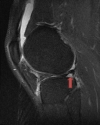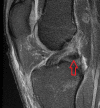MRI in the Diagnosis of Bucket Handle Tears: What Is the Current Situation?
- PMID: 37700980
- PMCID: PMC10493472
- DOI: 10.7759/cureus.43324
MRI in the Diagnosis of Bucket Handle Tears: What Is the Current Situation?
Abstract
Introduction The purpose of this study was to determine the utility of current magnetic resonance imaging (MRI) in the diagnosis of bucket-handle meniscal tears. Materials and methods Patients treated for arthroscopic meniscal tears between March 2019 and March 2022 were reviewed. The current study included all patients with bucket handle tears diagnosed arthroscopically and having MRI scans (n=51). A control group of 58 individuals with similar demographic characteristics and meniscal tears apart from bucket handle tears was also formed. The assessment of bucket handle and non-bucket handle tears was performed blindly by a musculoskeletal (MSK) radiologist with 20 years of experience and a trainee radiologist, achieving consensus on group allocation. The MRIs were examined for various findings, including the presence of a bucket handle tear, tear location, presence of anterior cruciate ligament (ACL) rupture, intercondyler notch sign, double anterior horn sign, flipped meniscus sign, double posterior cruciate ligament (PCL) sign, absent bow sign, and the disproportionate posterior horn sign. These well-known signs, detailed in the literature, were evaluated. Additionally, less studied and less commonly known signs such as the V sign and double anterior cruciate ligament sign were assessed. The V sign appears similarly to the letter V, resulting from the displacement of the bucket handle tear and the angle of the intact meniscus on axial images. The double anterior cruciate ligament sign is the appearance formed by the compression of the displaced meniscal part behind the anterior cruciate ligament in bucket handle tears. Results Following the retrospective evaluation of MRI scans, 44 out of 51 tears diagnosed as bucket handle tears by arthroscopy were accurately identified (sensitivity: 86.27%). The same conclusion was reached for MRI scans in 52 out of 58 tears where arthroscopy did not detect a bucket handle tear (specificity: 89.66%). The most prevalent MRI signs in patients with bucket handle tears identified by arthroscopy in the study were the intercondylar notch sign (84.31%), V sign (72.55%), double PCL sign (56.86%), double anterior horn sign (49.02%), absent bow sign (43.14%), flipped meniscus sign (19.61%), disproportionate posterior horn sign (9.80%), and double ACL sign (5.88%). The intercondylar notch sign, V sign, and double PCL sign exhibited the highest sensitivity, while flipped meniscus, disproportionate posterior horn, and double ACL sign demonstrated the highest specificity. Conclusion MRI demonstrates a high level of sensitivity and specificity in identifying meniscal bucket handle tears, particularly when considering the eight MRI signs investigated in this study.
Keywords: bucket handle tear; meniscal tear; meniscus tear; mri; signs.
Copyright © 2023, Pakdemirli et al.
Conflict of interest statement
The authors have declared that no competing interests exist.
Figures









Similar articles
-
Meniscal bucket handle tears: a retrospective study of arthroscopy and the relation to MRI.Knee Surg Sports Traumatol Arthrosc. 2006 Apr;14(4):343-9. doi: 10.1007/s00167-005-0678-x. Epub 2005 Sep 15. Knee Surg Sports Traumatol Arthrosc. 2006. PMID: 16163557
-
Bucket-handle tears of the medial and lateral menisci of the knee: value of MR imaging in detecting displaced fragments.AJR Am J Roentgenol. 1995 Sep;165(3):621-5. doi: 10.2214/ajr.165.3.7645481. AJR Am J Roentgenol. 1995. PMID: 7645481
-
Displaced Medial and Lateral Bucket Handle Meniscal Tears With Intact ACL and PCL.Orthopedics. 2015 Aug;38(8):e738-41. doi: 10.3928/01477447-20150804-91. Orthopedics. 2015. PMID: 26270763
-
Arthroscopic meniscal repair with use of the outside-in technique.Instr Course Lect. 2000;49:195-206. Instr Course Lect. 2000. PMID: 10829175 Review.
-
Single-stage repair of displaced bucket-handle meniscal tears with anterior cruciate ligament reconstruction leads to good meniscal survivorship : a retrospective cohort study.Bone Joint J. 2022 Jun;104-B(6):680-686. doi: 10.1302/0301-620X.104B6.BJJ-2021-1340.R2. Bone Joint J. 2022. PMID: 35638209 Review.
Cited by
-
Saving the Meniscus: A Retrospective Observational Study of the Incidence, Treatment, and Failure Rate of the Main Meniscal Tear Types at 24-Month Follow-Up.J Clin Med. 2025 May 12;14(10):3350. doi: 10.3390/jcm14103350. J Clin Med. 2025. PMID: 40429345 Free PMC article.
-
Creation and validation of a treatment algorithm for skeletally immature patients with acute anterior cruciate ligament injury based on MRI and patient characteristics.J Exp Orthop. 2025 Aug 5;12(3):e70280. doi: 10.1002/jeo2.70280. eCollection 2025 Jul. J Exp Orthop. 2025. PMID: 40766807 Free PMC article.
References
-
- Meniscal repair. Stärke C, Kopf S, Petersen W, Becker R. Arthroscopy. 2009;25:1033–1044. - PubMed
-
- MRI of meniscal bucket-handle tears. Magee TH, Hinson GW. Skeletal Radiol. 1998;27:495–499. - PubMed
-
- Use of the V-sign in the diagnosis of bucket-handle meniscal tear of the knee. Rao N, Patel Y, Opsha O, et al. Skeletal Radiol. 2012;41:293–297. - PubMed
LinkOut - more resources
Full Text Sources
